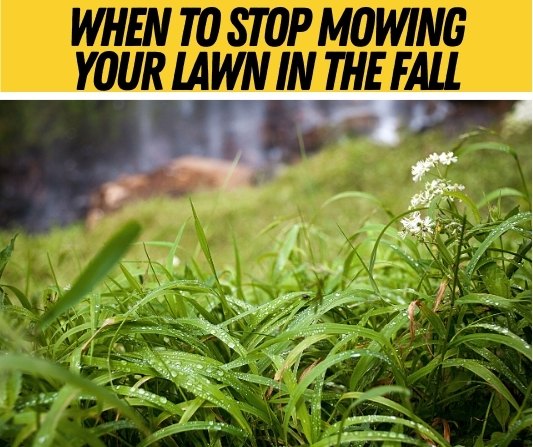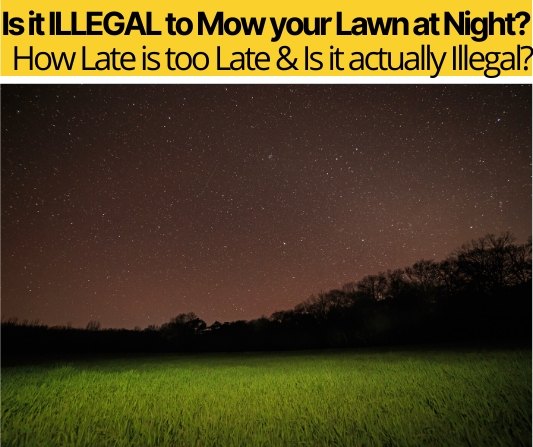 Knowing when to mow your lawn before winter is very important for your lawn’s health, and ensuring it is in prime condition come spring.
Knowing when to mow your lawn before winter is very important for your lawn’s health, and ensuring it is in prime condition come spring.
But of course, this is easier said than done, as knowing when to stop mowing your lawn changes depending on where you live, and differs slightly every year.
So when is it best to cut your lawn before winter?
When To STOP Mowing your Lawn in the Fall
As a general rule, mowing your lawn before the temperature goes below 50°F (10 °C) is the best time to cut your grass before winter. You should be monitoring the weather, and making sure it is cut several times in the run up to this change in temperature, as this will be the last opportunity you will have to tend to your grass properly. You can still do minor touch-ups to the lawn, and a light, high cutting will suffice in the winter. Anything more significant can cause damage.
However, there are different heights you will be wanting to cut your lawn to, depending on the time of year, as cutting it too short can be damaging— particularly in the run up to winter. You will want to tailor your lawn care to the month and temperature, and the frequency of mowing will change throughout the year.
When Should you stop Mowing your lawn & Should you Cut it Short For the Winter.
The lawn should be mowed a week or so before the temperature dips below 50°F (10 °C), and to the height of 2.5-3 inches. The reason for this is that you do not want to cut it too short so that it is struggling during the winter period, and then spending spring recovering, and you do not want to leave it so long that it develops snow mold. This can occur when snow melts over grass, and causes it to die.
You can cut your grass during any month of the year. If you think about it practically, you can’t leave your lawn unkept for the latter half of the year, just because it is winter, especially if you’re having guests around, or hosting an event. However, you will need to cut the grass differently during the winter months compared to the summer months. The last proper cut will be when the temperature dips below 50°F (10 °C), which is usually in October, but it depends on where you live. You should make sure that this is a good cutting, as you will only be able to do light mowing from thereon until spring.
Up until this point, you should be mowing twice a week for a healthy and well-kept lawn. You want to avoid mowing when it is wet, although increased perspiration will mean an increase in growth rate. In the fall you may have a lower cut compared to the summer, to keep up with how quickly the grass is growing. However, this will change when moving from September into October, as the growth will be slowing, as the temperature decreases. You will need to possibly heighten your cut, to accommodate for the slower growth rate, and mow less frequently. The final mow will be sometime in October, when the temperature has begun to fall below 50°F (10 °C) consistently. Any mowing after than will cause it to suffer until spring.

When is grass cutting season?
Regular mowing usually begins again in April, as the increase in temperature, paired with the rain, means the rate of growth will be reasonably high. However, it can be a good idea to get in a couple high cut cuttings in March, to prepare the grass for the thorough mows in April.
Central Western states such as Colorado can be more prone to snow mold than other regions, as when the snow melts it can cause more significant damage to the grass beneath. In the regions in and around Connecticut, where lawns thrive more easily compared to other states, you will find that your season may begin earlier than the East coast, and you will be cutting your grass more regularly. States in the deep South, i.e. Texas, can have the most difficulty with maintaining grass, due to the heat, and have to be careful as to how short they trim it in the summer. For all the states, grass cutting season will begin in April, with the warmer states starting earlier and the cooler states starting later in the month.
Can you still cut grass in October?
You can still cut the grass in October, and this should be the month in which you do your final thorough mow. Depending on your location, this could be more towards the beginning of the month, or the end, you should research when the first frost is expected. After your final cut, you can still trim the lawn, but do not cut too short or risk damaging the grass.
Can you still cut grass in November?
By November you should have ceased your regular mowing routine, and sought to only using high cuts that are light, just to keep the lawn neat. Because the grass will not be growing as quickly, and there is often a lot of rain in this month, you can damage the lawn by mowing it too deeply and too frequently. Especially towards the end of the month, when it is very cold, you want to seriously limit how much cutting you are doing. Also, when there is frost, it is a good idea to keep off the grass, as stepping on the blades in this condition can cause them to break.
Can you still cut grass in December?
December is one of the most difficult months to mow during, as the temperature is so cold. However, you may have all the more reason to, if you’re having friends over for Christmas or New Year’s, so a tidy lawn may be required. You can mow your grass in December, but be careful. Perform a high cut, with the sole purpose of tidying up the esthetic, rather than shortening it. It can be best to cut your grass once during December, at most, and use it just before a social occasion that permits it. Do not cut on a wet or snowy day.
How often should you mow your lawn in winter?
This entirely depends on the weather and where you live. In there’s a lot of rainfall, and it is a particularly mild winter, you will find yourself cutting the lawn more so, than if it is consistently snowy and cold. If the grass length is creeping up to 4 inches or more in length, then you may want to trim it slightly, in order to maintain neatness and health.
However, if the grass is not growing particularly fast, and it is consistently damp, then you may opt to not mow for long periods of time. It is less about how often, and more about how long is the grass getting, and what the temperature is. If it around or above 50°F (10 °C), dry weather conditions, and the grass is getting long, a little trim won’t do any harm. However, do not mow the grass anything below 2.5 inches, or you risk damaging the grass for the rest of the winter.
Lawn length for winter
As previously mentioned, 2.5-3 inches is the ideal lawn length for the winter period. This is because it is not too long to look untidy, or to become soggy and encourage the growth of moss. It is also not too short that it will not be able to sustain itself during the winter period. Grass too short will really struggle during the winter, and possibly die, meaning it will take some time to recover during the spring. The length of your lawn in winter can have an adverse effect on the quality of your lawn in the summer.
How cold before grass stops growing
The grass will seriously slow in rate of growth at around 50°F (10 °C), at which time it is best to stop cutting, or doing large mows. Then, around 40°F (4.4 °C) the rate of growth will be miniscule, but grass never really stops growing, it just slows down in its rate. This is why some people still cut their grass lightly in the winter, because it can become untidy over the months.
Should I cut my grass shorter before winter?
No, this is in fact very bad for a lawn, and could cause it to die during the winter. A lawn should be 2.5-3 inches during winter, and in fact for most of the year. In spring, it should be a little longer, to help prevent weeds from growing, but otherwise the standard 2.5-3 inches should be continued all year round. Trimming the grass, i.e. removing the top third of the plant, encourages growth and leaves the lawn in a healthy state. Cutting the grass too short can be damaging to the lawn, especially just before winter.
Is it better to leave your lawn long or short for winter?
If it is one or the other, leaving it long will prevent it from being damaged more easily from snow and rain, and give it the best chance of surviving, although it is still not ideal. Short grass will have less nutrients and therefore less energy to survive the winter, compared to long grass. If you are worried about cutting your lawn too short, and it is reasonably long, it would be best to leave it until the temperature increases again in the spring.
Related Questions.
Will frost damage fresh cut grass?
Grass is more susceptible to frost damage when it has just been cut, and so it is best to mow the lawn before the first frost. It can cause the cells within the grass to be destroyed, and therefore causes patches of your lawn to die. This is why it is best to avoid cutting the grass before frost, and it can damage the grass. Frost itself can be damaging to grass, even when it hasn’t been cut recently, as the grass is literally frozen, and therefore prone to breakage.
Can you damage your lawn by mowing it late in the fall, after the first freeze
You are very likely to damage your lawn by mowing it after the first frost, particularly if it is liable to freeze over soon again. Frost causes damage to grass, particularly if it has been cut, so it is better to cut the grass sooner rather than later, when approaching the wintery months.
You might Find Useful: Is it Illegal to Mow your Lawn at Night






